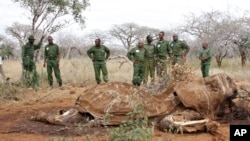An extraordinary conference of the Organization for Wildlife Conservation in Africa and the 15th meeting of the 10 member Congo Forest Basin has ended in Yaounde with a statement of intent to save Africa's wildlife whose future, the documents authors say, is threatened.
Jef Dupain, director of the African Wildlife Foundation which works together with the people of Africa to protect wildlife and wild lands, says poaching has become a multi-billion dollar illegal wildlife trade with devastating consequences for elephants and large animals in the Congo basin, one of the world's richest biodiversity areas.
"There is the slaughter of the elephants going on, losses of populations of great apes and of many other animals. The creation of protected areas might have decreased the loss to a certain extent, but we can't say that we are winning the battle right now whether this has to do with national security, whether this has to do with poaching, livelihoods, well-being of the local communities,” said Dupain. “You need a diversity of partners working together with African people to secure the future of the African wild lands and wild animals because if you don't act more powerfully, the situation will become more desperate."
Ngeh Paulinus of the Wildlife Trade Monitoring Network says the massive slaughter of elephants for ivory became an international concern when armed Janjaweed groups from Sudan began killing the animals for ivory to fund their activities.
"Sixty-two percent of the elephants in central Africa have been lost. The black rhinoceros of central Africa is now extinct. Those are two factors that indicate the seriousness of the problem," says Paulinus.
‘Second-largest tropical rain forest’
The Congo basin is the second-largest tropical rain forest on Earth. Its rich and diverse ecosystem provides food, fresh water and shelter for millions of people spanning 251 million hectares — from central African countries through the Atlantic Ocean's Gulf of Guinea to the mountains of the Albertine rift.
Professor Zac Tchoundjeu of the International Center for Research in Agro Forestry says the killing of wildlife and unsustainable exploitation of the Congo forest is taking a toll on the entire natural resources of the basin.
"If the landscape is not there, the wildlife will go," he said. "If the wildlife is not there, other [natural species] will lose, so we need to protect all the biodiversity and protect our environment and protect our forest and reconstitute our forest."
During the meeting in Yaounde, concerns were raised that many illegal hunters collaborate with the local population who are basically poor and vulnerable. John Fa, professor of biodiversity and human development at Manchester Metropolitan University, says there is a growing need to empower communities in the Congo basin.
"Generally people are eating porcupine, people are eating rats. These are very productive species that can actually do very well wherever you put them," he said. "So what we are saying is that there are some species that can be hunted sustainably for the benefit of people, but the large species like elephants and great apes and even some primates, some monkeys, are better not touched."
Cameroon's Minister of Wildlife, Ngole Philip Ngwesse, says Africa needs to rally behind the May 2015 African-led strategy and action plan to combat the illegal trade of the continents natural resources drawn up in Congo Brazzaville.
Professor Fa lays a large part of the blame on China.
"The problem we have with elephants now is the fact that China is the main country buying the ivory that is coming out of Africa, so the Chinese have to take the example and say we are responsible for this and we shouldn't be actually supporting the sale or the buying of ivory," he said.
The Congo Basin Forest Partnership of countries and groups working for conservation is home to three of the world’s four species of great apes. There are approximately 10,000 species of tropical plants in the basin and 30 percent are unique to the region.








